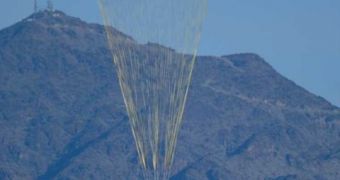The most recent parachute test that NASA conducted in the Arizona desert, near Yuma, was meant to test the parachute system on a 50,000-pound booster. Although the payload was a dummy, the heft it carried was not, and officials at the space agency and the US Air Force were anxious to see whether the lifting devices would work. The success of this test is crucial for the next Ares mission, as the plan is to retrieve and reuse the expended rocket boosters on the carrier systems after each launch.
In other words, with each launch, after these modules separate from Ares, they will deploy parachute systems similar to this one, which will guide them into a soft landing, without too much damage coming to the metallic structures themselves. In the latest test, the booster that will equip Ares I was duplicated with a steel “missile,” which was loaded with just as much heft as the next-gen boosters will be, although NASA admits that it will continue to test the system on heavier payloads as well.
“NASA's new Ares moon rocket is going to have a reusable booster stage that we plan to recover after each mission. To 'catch' the booster before it crashes back to Earth, we need a super-reliable parachute system,” explains Marshall Space Flight Center scientist James Burnum. This system consists of a small pilot chute, which is the first to deploy. It then pulls out a 68 foot (21 meter)-diameter drogue parachute, whose aim is to slow down the booster, and to orient it vertically.
After that stage, the three main parachutes will be deployed, and they will actually ensure that the craft lands unharmed to its designated position. “We flew at 175 knots at 25,000 feet (7620 meters), and dropped one of the heaviest payloads a C-17 has ever carried – a 50,000-pound stand-in for the spent Ares booster. A lot of things have to happen correctly for such a test to be successful,” NASA's Dryden Flight Research Center chief pilot, Frank Batteas, shared.
“The steel 'missile' used for testing has cavities for adjusting the weight of the payload. We'll reuse it for future Ares parachute testing with 70,000, 77,000, 85,000, and finally 90,000-pound payloads,” concluded C-17 Mission Systems Engineer Franz Ravelo, who is a part of the team at the Air Force Flight Test Center, of the Edwards Air Force Base, in California.

 14 DAY TRIAL //
14 DAY TRIAL //